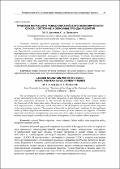| dc.contributor.author | Артюхин, М. И. | |
| dc.contributor.author | Пушкевич, С. А. | |
| dc.coverage.spatial | Гомель | ru_RU |
| dc.date.accessioned | 2023-09-21T10:56:12Z | |
| dc.date.available | 2023-09-21T10:56:12Z | |
| dc.date.issued | 2023 | |
| dc.identifier.citation | Артюхин, М. И. Трудовая миграция в рамках Евразийского экономического союза: состояние и основные тренды развития / М. И. Артюхин, С. А. Пушкевич // Менталитет славян и интеграционные процессы: история, современность, перспективы : сб. науч. тр. / М-во образования Респ. Беларусь [и др.] ; под общ. ред. В. В. Кириенко. – Гомель : ГГТУ им. П. О. Сухого, 2023. – С. 97-99. | ru_RU |
| dc.identifier.uri | https://elib.gstu.by/handle/220612/28800 | |
| dc.description.abstract | Развитие внешней трудовой миграции населения на постсоветском пространстве
во многом определяется процессом межгосударственной интеграции новых независимых государств. В настоящее время создано такое межгосударственное интеграционное образование,
как Евразийский экономический союз. В рамках этого интеграционного союза идет процесс
формирования общего рынка труда и единого миграционного пространства, что способствует развитию внешней трудовой миграции в странах-участницах. Создание благоприятных
социально-правовых условий осуществления трудовой миграции определило привлекательность этих стран для мигрантов. Благоприятные правовые и социальные факторы трудоустройства и защиты прав трудящихся-мигрантов из стран-участниц ЕАЭС во многом
содействуют динамичному развитию межстрановой трудовой миграции. | ru_RU |
| dc.description.abstract | The development of external labour migration of the population in the post-Soviet space is
largely determined by the process of interstate integration of new independent states. At present, such
interstate integration formations as the Eurasian Economic Union have been created. Within
the framework of this integration union, the process of forming a common labour market and a common migration space is underway, which contributes to the development of external labour migration
in the participating countries. The creation of favorable social and legal conditions for the implementation of labour migration determined the attractiveness of these countries for migrants. Favorable
legal and social factors of employment and protection of the rights of migrant workers from the EAEU
member states largely contribute to the dynamic development of intercountry labour migration. | |
| dc.language.iso | ru | ru_RU |
| dc.publisher | ГГТУ им. П.О. Сухого | ru_RU |
| dc.subject | Внешняя трудовая миграция | ru_RU |
| dc.subject | Трудовые мигранты | ru_RU |
| dc.subject | Рынок труда | ru_RU |
| dc.subject | Государственная миграционная политика | ru_RU |
| dc.subject | Интеграционные межгосударственные союзы | ru_RU |
| dc.subject | External labour migration | ru_RU |
| dc.subject | Labour migrants | ru_RU |
| dc.subject | Labour market | ru_RU |
| dc.subject | State migration policy | ru_RU |
| dc.subject | Integration interstate unions | ru_RU |
| dc.title | Трудовая миграция в рамках Евразийского экономического союза: состояние и основные тренды развития | ru_RU |
| dc.title.alternative | Labour Migration Within the EAEU: State and Main Development Trends | ru_RU |
| dc.type | Article | ru_RU |
| dc.identifier.udc | 314.15(476) | |
